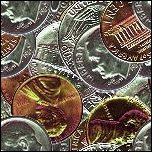
Coin Collecting
About Coins and Notes
 |
A Window on ... Coin Collecting About Coins and Notes |
 | The First Coins and Banknotes The first coins were used over 2,000 years ago in Greece. They were egg-shaped pieces of metal, made from a mixture of gold and silver. One side of the coin was marked with the weight that showed its value and the other side had a personal stamp, mark or seal imprinted on the metal. This was the mark of the person who guaranteed the weight and therefore the value of the coin. Stamping the coin in this way was known as 'minting'. Since that time all the great empires have produced their own coins and gradually all the countries of the world introduced a coinage system. The first coins were used over 2,000 years ago in Greece. They were egg-shaped pieces of metal, made from a mixture of gold and silver. One side of the coin was marked with the weight that showed its value and the other side had a personal stamp, mark or seal imprinted on the metal. This was the mark of the person who guaranteed the weight and therefore the value of the coin. Stamping the coin in this way was known as 'minting'. Since that time all the great empires have produced their own coins and gradually all the countries of the world introduced a coinage system.The Chinese were the first to use banknotes over 1,000 years ago but they did not become popular until the fourteenth century. A banknote was a promissory note from a bank. The bank who issued the note promised to pay the holder a certain amount of coins in exchange for it. The first European bank notes were issued by a Swedish bank in 1661 but they did not last long because they were not supported by the government and the bank had to close. The first permanent European bank notes were issued by the Bank of England in 1694. Old bank notes are much rarer than coins because they are made of a less durable material.
| |||||||||||
 | Today's Coins and Bank notesThe coins of today come in various shapes and sizes and are made from a range of metals including gold, silver, copper, nickle, bronze, aluminium and steel. Just like the first coins, they are 'minted' to show their value.Banknotes are still promissory notes and they too come in various sizes and colours. The currency notes of each country are issued and supported by a country's national bank. For example, £5, £10, £20 and £50 notes are issued by the Bank of England, American dollar notes are issued by the Bank of America, and Scottish notes are issued by the Bank of Scotland. They are accepted at any bank in the country because they are guaranteed by the National Bank.
|
|||||||||||
 | All About Coins and Bank notesAlmost all coins and notes
The front face of a coin, known as the obverse side, usually has a design showing the head of state. The design on the reverse side of a coin is of something relating to the country, perhaps a flower, a coat of arms, a symbolic figure, or a bird. The figure of Britannia has appeared on several British coins for hundreds of years. The artwork on a bank note is more realistic and often uses more than one colour. Some designs are very intricate. This helps to prevent forgeries.
Commemorative Coins
Face Value
Country names
Year of issue
Rims and edges
|
|||||||||||
| ||||||||||||
|
| ||||||||||||